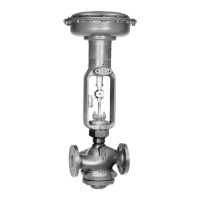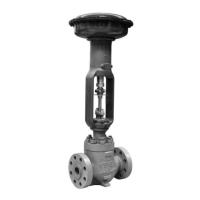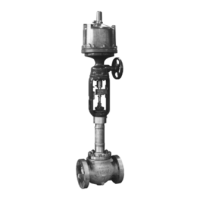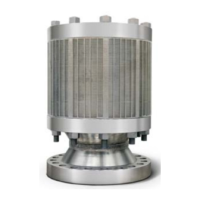Instruction Manual
D100399X012
EW Valve
July 2017
13
Note
Proper performance of the tightening procedures in step 11 compresses the spiral wound gasket (key 12, figure 22 through 23) or
load ring (key 26, figure 24) enough to both load and seal the seat ring gasket (key 13, figure 22, 23 or 24). It also compresses the
outer edge of the bonnet gasket (key 10, figure 22 through 24) enough to seal the body‐to‐bonnet joint.
The proper bolting procedures in step 11 include‐‐but are not limited to‐‐ensuring that bolting threads are clean, and evenly
tightening the nuts onto the studs in a criss‐cross pattern. Because of the bolt‐up characteristics of spiral wound gaskets,
tightening one nut may loosen an adjacent nut. Repeat the criss‐cross tightening pattern several times until each nut is tight and
the body‐to‐bonnet seal is made. When the operating temperature has been reached, perform this torquing procedure once
again.
Note
Stud(s) and nut(s) should be installed such that the manufacturer's trademark and material grade marking is visible, allowing easy
comparison to the materials selected and documented in the Emerson/Fisher serial card provided with this product.
WARNING
Personal injury or damage to equipment could occur if improper stud and nut materials or parts are used. Do not operate or
assemble this product with stud(s) and nut(s) that are not approved by Emerson/Fisher engineering and/or listed on the
serial card provided with this product. Use of unapproved materials and parts could lead to stresses exceeding the design
or code limits intended for this particular service. Install studs with the material grade and manufacturer's identification
mark visible. Contact your Emerson Automation Solutions representative immediately if a discrepancy between actual
parts and approved parts is suspected.
11. Lubricate the bolting (not necessary if factory pre‐lubricated stud bolt nuts are used) and install it, using proper
bolting procedures during tightening so that the body‐to‐bonnet joint will withstand test pressures and application
service conditions. Use the bolt torques in table 5 as guidelines.
12. Install new packing and the metal packing box parts according to the appropriate arrangement in figure 4, 5, or 6.
Place a smooth‐edged pipe over the valve stem and gently tap each soft packing part into the packing box.
13. Slide the packing follower, upper wiper, and packing flange (keys 13, 12, and 3, figure 21) into position. Lubricate
the packing flange studs (key 4, figure 21) and the faces of the packing flange nuts (key 5, figure 21). Install the
packing flange nuts.
14. For spring‐loaded PTFE V‐ring packing, tighten the packing flange nuts until the shoulder on the packing follower
(key 13, figure 21) contacts the bonnet.
For graphite packing, tighten the packing flange nuts to the maximum recommended torque shown in table 6. Then,
loosen the packing flange nuts, and retighten them to the recommended minimum torque shown in table 6.
For ENVIRO‐SEAL or HIGH‐SEAL live‐loaded packing, refer to the note at the beginning of the Packing Maintenance
section.
For other packing types, tighten the packing flange nuts alternately in small equal increments until one of the nuts
reaches the minimum recommended torque shown in table. Then, tighten the remaining flange nuts until the packing
flange is level and at a 90‐degree angle to the valve stem.
15. Mount the actuator on the valve assembly, and reconnect the actuator and valve stem according to the procedure
in the appropriate actuator instruction manual.

